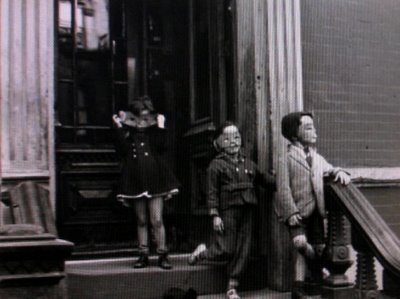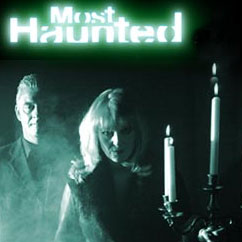Haunted Songs for All Hallow's Eve
 In a pioneering collaborative cross-post with my music-geek brother over at Pop with a Shotgun, I offer here a selection of songs that have unnerved, unhinged, disjointed, disturbed, and/or flat-out frightened me over the past year and in years past.
In a pioneering collaborative cross-post with my music-geek brother over at Pop with a Shotgun, I offer here a selection of songs that have unnerved, unhinged, disjointed, disturbed, and/or flat-out frightened me over the past year and in years past. Happy Halloween — hope y’all find some sweet candy in your bags, heh-heh.
1. “SHE MOVED THROUGH THE FAIR," artist unknown
Few folk songs have been recorded as often as this one. Folkies love it because it smells of the ancient, while New Agers love it for its affirmation of life after death and love, or at least romance, everlasting. Certainly every musician with a drop of Irish blood has taken the lance to it: versions exist by John McCormack, Elvis Costello, Van Morrison, Sinead O’Connor and The Chieftains, Loreena McKennitt, and so on. The modern lyrics were written by Padraic Colum, poet, novelist, dramatist, and folklorist of Eire, and the tune, by Herbert Hughes, was based on a fiddle air collected in Donegal in 1909; but some form of the song surely dates back to Medieval times and beyond.
Perhaps the best-known version to rock and roll ears — and the style-setter for most later covers — is by Fairport Convention; sung by the late Sandy Denny, it’s on their second album, What We Did on Our Holidays (1969). Denny’s version was based on a precursor by Anne Briggs, and Briggs got it from locally famed Irish banjoist and “traveling singer” Margaret Barry (1917-90). Barry, who had been singing the piece for decades in various long and short versions, can be credited with keeping it alive until modern pop had a chance to discover it. Her sharp, bloody rendition is heard on the Rounder compilation I Sang Through the Fairs, containing songs and memories recorded in discussion with Alan Lomax in 1953.
A bit of web-trawling will reveal any number of versions posted by musicians on the various state-fair and city-jamboree circuits. Few are unlistenable. Listed here is one of the simpler versions I turned up: a single twice-echoing pipe of wood, blowing improvisatory variations on the song’s basic lines. I don’t remember who recorded this, and I can’t rediscover where I found it; but I can hear the piper’s breath draw up sharp and nervous between each long, long phrase. It feels like he’s right here with me. It’s an invocation of the night and whatever might be waiting to come out.
2. “(GHOST) RIDERS IN THE SKY,” The Ramrods
Somewhere out in the American West, as if in response to the Irish pipe, skies darken and apparitions appear.
This song’s author, Stan Jones, grew up on the prairie and recalled the old cowboy’s warning to reckless boys: Look into the sky, and you can see the ghost herd. Be careful out here, or you’ll join it one day. On his 34th birthday, at his home in Death Valley, Jones wrote a song that sounded as old as the ghosts it imagined.
Since then it’s been a favorite of old cowboy stars, nightclub crooners, and garage bands alike, done by Roy Rogers and Spike Jones, Johnny Cash and Peggy Lee, Burl Ives and REM. The Ramrods’ instrumental was the big hit version of the rock era, reaching the Top 30 in February 1961. The snap and beat of the band sound like surf, but the voices that fly over and streak past — whip-snapping cowpokes, a wailing woman — are the sound of that thundering herd, that mythic mass of spirits.
3. “DEVIL GOT MY WOMAN,” Skip James
A small Midwestern town. A man sits on a corner. He plays the guitar, thumps his heel down below for a subtle pulse, and cries high. His cry hangs on the gray afternoon wind for five minutes’ time. He sings about the devil, and about a woman. You know I’d rather be the devil, than to be that woman now. Maybe ten people walk by in those five minutes. One passerby slows, double-takes the shut-eyed singer, stops to listen. Then gets scared, looks at the sky, and hurries on.
By the end of the song, it has turned to night. There’s no sound but the wind and a rusty weathervane turning somewhere above. The man packs up his guitar, walks off, and is never seen again.
Note: I specify the latter-day remake, from the 1968 LP of the same title, over the 1931 Grafton recording.
4. “PHANTOM 309,” Red Sovine
Headlights on the highway, coming around the turn. Sovine, king of the trucker’s ballad, here reverses the legend of the phantom hitchhiker — the wandering ghost, usually a girl, who flags a ride with some unsuspecting motorist in the hope of finding her way home. In Sovine’s version, it’s the hitchhiker-narrator who is the innocent. Down on his luck, he snares a ride with trucker Big Joe, who takes him up the road to a diner and tosses him a dime for coffee. When he tries to cash it in, explaining where he got it, It got deathly quiet . . . and the waiter’s face got kinda white.
Turns out Big Joe took a fatal skid some time back: he twisted his wheel and went to his death rather than collide with a school bus.
5. “SALLY GO 'ROUND THE ROSES,” The Jaynetts
“Spookiest and most exotic of all girl group discs,” Dave Marsh called this, placing it #377th in The Heart of Rock and Soul: The 1001 Greatest Singles Ever Made (1989). Your blogger wouldn’t argue.
The song, Marsh says, “operates as a metaphor, but its message is as murky as week-old gossip. Superficially, Sally’s friends are just warning her against going downtown, because there she’ll find the ‘the saddest thing in the whole wide world,’ her baby with another girl. But the mix and arrangement and the odd metaphor of the endlessly repeated chorus (‘Sally, go ‘round the roses / They won’t tell your secret’) lend the entire production an ominous air, as if some deeper tale waits to be told.
“A quarter century later, after endless spins, it’s no closer to being revealed.”
6. “JOHNNY REMEMBER ME,” John Leyton
The galloping rhythm, the windy echo, the dead girl wailing in the treetops. It’s all Joe Meek: poor mad, brilliant, dead Joe Meek. And it has the power to make you think of Wuthering Heights. Or Goethe’s The Erl-King. Or “Ghost Riders in the Sky.”
I first heard this song on January 21, 2001, at the Walter Reade Theater in New York, while watching a seldom-screened two-part BBC documentary called The Brian Epstein Story. That was a strange, strange night: I met someone who was a ghost, or might as well have been. I’ve got witnesses.
I wrote about it once. To be continued . . .
7. “HOPE THERE'S SOMEONE,” Antony & The Johnsons
If you’re feeling life is too scary to be lived, don’t listen to this. It might convince you you’re right.
8. “DON'T FEAR THE REAPER,” Blüe Oyster Cult
Poison-flavored bubblegum. It’s a joke, some would say not even a good one: “proto-Jehovah’s witness crap,” Marsh called it, “that doesn’t scare (or convince) anybody.” Anybody but me and a few million others. No kid who grew up white, Midwestern, and radio-fixated in the 1970s is without some feeling about this record. You hate it or you love it, or you just shiver when you hear it. It’s like the line from The Usual Suspects: “I don’t believe in God, but I’m scared of him.” I don’t believe in this record, but I’m scared of it.
9. “NAKED IN THE AFTERNOON,” Jandek
Loathsome schizo wanders the impeccable rooms of his suburban Houston home and plots gruesome acts, turns them into twanging, dissonant, tuneless, endless songs. Scares hell out of anyone who has sense enough to not listen to too much of it at once.
10. “WHO DO YOU LOVE,” Ronnie Hawkins
Bo Diddley wrote the lyrics, and they’re lyrics that white would-be badasses like Jim Morrison and George Thorogood have never tired of trying to live up to, earn the right to understand. But what’s to understand? This is the rock and roll graveyard, more vivid than any psychobilly extravagance, subtler than Screamin’ Jay Hawkins, no “Monster Mash” sitcom. This is the Devil coming through. He’s horny, hustling, setting fires, spreading evil.
I walked 47 miles of barbedwire, use a cobrasnake for a necktie
Got a brandnew house by the roadside made from rattlesnake hide
Got a brandnew chimney made on top made from a human skull
Bo Diddley’s original has a haze on it, an aural thickness, an unreality: all that tremelo on his rectangular guitar and cheap amplifier makes the graveyard night fat, soft, surreal, a convocation of Epicurean demons. Ronnie Hawkins, gripped by something — maybe an evil mood, maybe the white would-be badass’s drive to outfrighten the frightener — gets closer to something really raw, really scarred.
I got a tombstone hand and a graveyard mind
I lived long enough and I ain’t scared a dyin’
This is the only record on my list of ghastlies that is sexy and scary both — and probably the only one that wants to be both. That makes it perverse. And that perversity wins Ronnie the right to say he understands, to claim that he has gone all the way there and returned to tell the story, that he reached his hand into the very fires of the deepest pit and will show you the burn.
The night was black and the moon was blue
And down the alley an icewagon flew
Bump was hit lord and somebody screamed
You should a heard just what I seen
This song features one of the great unanswerable non-sequiturs in modern art, up there with I am the Walrus and Mein Feuhrer, I can walk!! And Hawkins does justice to it — to Bo Diddley’s greatest line, his greatest rock and roll idea, an idea that has no right to be scary but nonetheless is:
Who do you love?
11. “LONG LONG LONG,” The Beatles
God, this is so quiet. So, so, so quiet. As a kid I couldn’t hear it: getting my head next to the speaker to hear the words, catch the little noises, was an experiment in fear. Because I knew the song was going to rear up, that it was coming to get me. First in the middle eight, So many years I was searching — one of the simplest and most powerful stretches of music and lyric George Harrison ever wrote — and finally at the climax, when haunted electronics surge upward from the wires and circuits like buried evil at the end of Five Million Years to Earth, and George opens his mouth to release a sound so unearthly, so —
Possibly the scariest song on what is certainly the scariest rock and roll album there is.
12. “BANSHEE,” Henry Cowell
We’ve heard many imitations and apprehensions of the banshee up to now: ghost riders, spirit lovers. Here she speaks for herself in extended shrieks and low drawn-out groans, with composer Henry Cowell as medium. Set amid the futurisms and constructivisms of the 1958 Folkways LP Sounds of New Music — which features such avant-garde curios as Soviet symphonies for power station and steel foundry — this piece of primitive horror protrudes like a gnarled finger. Cowell manually batters and caresses the exposed strings of a grand piano: “By scratching, plucking, pounding and sweeping the strings and taking full advantage of the strings’ sympathetic vibrations,” the liner notes read, “the composer has perfectly evoked the Banshee of Irish and Scottish folklore, the female spirit whose wailings forewarn families of the approaching death of a member.”
13. “VENUS IN FURS,” The Velvet Underground
Me + this song + a dark room = never in a million years.
14. “THE LONG BLACK VEIL,” Lefty Frizzell
The song is a natural ghost story, a piece of commercially canny pop that came out a fully-formed myth: like “Ghost Riders,” it could have been written a century before it was copyrighted. Frizzell’s original version, a hit in 1959, is still preferable to any other. It’s the only one that serves the song’s ghostliness, rather than its sense of biblical justice (Johnny Cash) or its ain’t-that-tough-shit bluesiness (the Band). Frizzell never goes above or below a pitch and energy that are dazed, oddly serene, the crooning equivalent of a whisper, as if he truly is the ghost he claims to be. Behind him, a dobro cries: the banshee is loose again. Stories like this — this must be where banshees come from.
15. “I WONDER AS I WANDER,” John Jacob Niles
You may have first heard Niles, as I did, only about a year ago — in No Direction Home, the half-baked Martin Scorsese/“American Masters” Dylan documentary. You may have felt, as I did, electrified and terrified at the too-brief bit of Niles’ long-ago television rendition of his song “Go ‘Way from My Window,” the key image of which Dylan purloined. You may have experienced the Niles wail as a sudden hot quiver in your nerve center, and felt, as I did for just a second, that no one had ever made a sound remotely so frightening. You may have felt, as I did, that you’d never felt fear before that moment. You may then have rushed, as I did, to hear more by this man.
You may never forget, as I will not, the sound of the voice I wonder the sound as I of the banshee wandahhhhhhhhhhhhhhhhhhhhh
16. “SHE MOVED THROUGH THE FAIR,” Menya Wolfe
Did I remind you up front that this song is a ghost story?
My young love said to me, my mother won't mind
and my father won't slight you for your lack of kind
And she laid her hand on me, and this she did say
Oh, it will not be long, love, till our wedding day
I’ve been hearing this song as long I can remember, but about a year ago I became obsessed with it. I trolled the net and the record catalogs to grab every version I could find. I found Anne Briggs’, and Margaret Barry’s, and many others. A few were good, most were okay, many were interchangeable — same drone, same bonnie lass enunciating cold and clear across an Irish spring.
Then I clicked a link and found myself in a very strange place.
A woman was singing, accompanied by a harp. The voice was that of a trained professional, deliberate, crystalline, almost unnaturally high — not in pitch but in ethereal location: it seemed to be of the sky, not merely aimed at it. The harp rang, well, like a harp. But it was the raw sound, over and above the musician’s technique, that transfixed and transported me. I guessed the piece had to date from the 1920s, or even earlier: clearly the recording had been subjected to many audio strippings and sandings, many rounds of noise reduction. And here it was, whittled down to some exquisite essence of sound, some spirit of music — primitive, without physicality, without body. It was all air, feeling, light, atmosphere. I swore I even heard the twittering of birds over the music. It sounded, I’m not entirely embarrassed to say, like music made by an angel.
Well, I’m an atheist, so angels scare me. I sat there bewildered, trembling, not believing. Nonetheless I did some back-clicking and got to the source of the thing.
What I found was a website devoted to a Toronto woman named Menya Wolfe. From the photos and news stories collected by the friends who’d built the site, I learned something of her life. She’d been a musician, archeologist, and artist. Diagnosed with breast cancer in 1996, she had begun an e-mail support group for cancer patients to share information and experiences — a common enough thing now, but not then. The group grew to a membership of 700.
Menya Wolfe began treatment for her illness, which was of an especially rare and inflammatory type.
And she went away from me and moved through the fair
and fondly I watched her move here and move there
And then she went onward, just one star awake
like the swan in the evening moves over the lake
The recordings posted at Menya’s site are, like “She Moved Through the Fair,” of a classical-folk stripe, and include other ghostly or macabre songs like “House Carpenter” and “Two Corbies” (aka “The Twa Corbies” or “The Three Ravens,” an ancient Scottish ballad representing the dialogue between predator birds as they prepare to dine on the remains of a fallen knight — we used to sing that in grade school). But these songs were recorded years before Menya got sick; in fact, her husband Pete Bevin writes, she “sang and played these pieces in 1990 for a friend who, ironically, was dying of breast cancer at the time.” There is nothing of foreshadowing, depression, or self-pity about the recordings; they are clear, sweet, and haunting, as if utterly innocent of tragedy. They’re available for download, and they comprise something almost too painful to hear.
The songs, Bevin says, were recorded on a boombox in Menya’s basement, and are “the only surviving recording of her work.”
Last night she came to me, my dead love came in
So softly she came that her feet made no din
And she laid her hand on me, and this she did say
Oh, it will not be long, love, till our wedding day
Menya Wolfe died February 13, 2001, age 36.






















